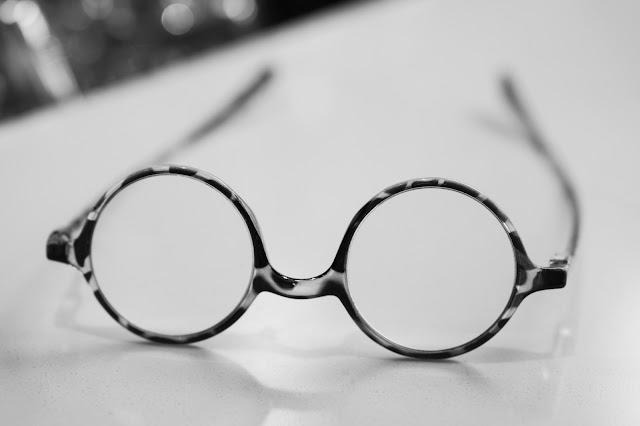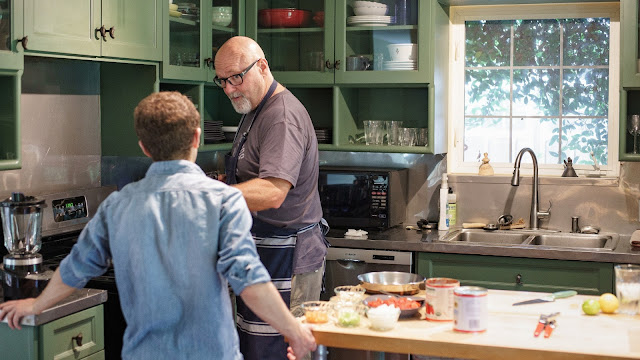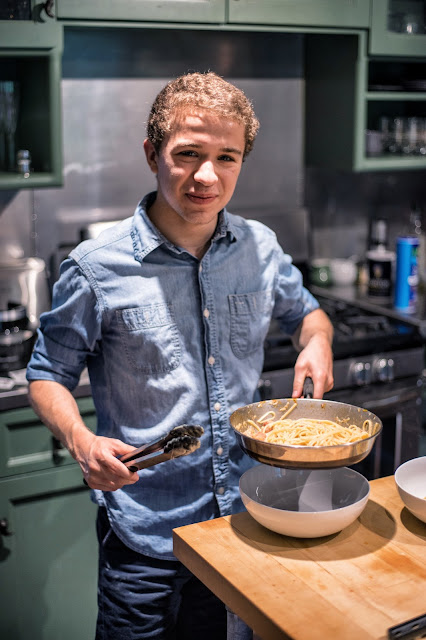From the Zach Theatre production of "Alice in Wonderland."
We've moved from sheet film to roll film, to small digital, and then to larger and larger digital, but we still tend to photograph in much the same way we always have. We're a bit more carefree now since our experimental indulgences have fewer temporal or financial consequences; but really, if you are a working photographer you are mostly doing the same stuff over and over again for decades. It just seems that in every decade we have a whole new set of tools in our hands and slightly different lights on the stands...We wear more black now but we photographers still make silly poses while we shoot and scrunch up our faces to look into the viewfinders.
Thirty years ago we shot portraits for clients. They weren't for anyone's website, they were mostly used as prints (5x7s) that got sent around to various magazines and newspapers to be used with business articles, or business profiles. If we did a great job, and thought about our work in a wider sense, it sometimes made the jump from a couple columns in the local newspaper to inclusion in an annual report or capabilities brochure. Most of these images were shot with medium format cameras and, of course, they were done on film. The process was more involved but the holistic arc of creation was pretty much the same. If we were working for an ad agency we shot the portraits and then produced contact sheets for selection purposes. If we were working directly with clients, who were less familiar with the photography process, we'd produce 4x5 or 5x5 or 4x6 inch proof prints; depending on the camera format. It always seemed easier for corporate marketing departments to look at the bigger prints when they were working out exactly which frame would make Mr. Smith seem the most... impressive.
Once they made a choice we'd make prints, or have prints made, which the clients would then distribute to the media channels. If one of the images made the cut to the brochure level, and we'd originally shot it on color negative film, we'd have the lab make a custom 8x10 inch print to deliver to the color separator. Most color separators back then were not happy to work with a negative (and I didn't blame them).
The process is so very much the same now. We shoot images for portraits and then we build a web gallery for selection purposes. Agencies are competent to make their choices from web galleries but direct clients like to see a selection of images right next to each other. Corporate marketers seem to have no mental persistence of vision in their tool kits. They'll make a preliminary selection set and then we'll put all three or five or eight selected images into one canvas so they can scroll around their screens and see the images together. Once final selections are made we retouch and color correct the images and then deliver them as high res files so our clients can distribute them to the media channels, and maybe consider them for corporate websites, and advertising collateral; both electronic and traditional print.
The client needs haven't really changed. They need to have images that make their people look painless to do business with and they need to look contemporary. Whether that look is still a well tailored business suit or a black t-shirt and jeans is immaterial.
Our overall process breaks down in the same way: Acquire the client. Create the raw product in a portrait photography session. Share the many iterations that were created during the session via some sharing method. Get the final selection(s) from the client and then scrape off the rough edges and enhance the final product for delivery. Wake up tomorrow and do it again.
The clients change from time to time; depending on which industries are ascendant in the moment. But oddly enough, present day mass media generates a homogeneous range of visual styles that are mostly easy to replicate or morph. The images we shoot today could have been shot with the tools from decades ago, easily. The only things that have changed are lighting styles, posing styles and color palettes.
As a portrait photographer I hear the same jokes from generation to generation. "I am so ugly I am afraid I'll break your camera!" "Can you make me look 20 pounds thinner?" "I'm ready for my close-up." "Say cheese." "Cold Blue Steel." For some reason grown up adults in each generation think it's funny to photo bomb their colleague who is being photographed. Men love to tease each other about the idea of wearing make-up; even if we aren't doing make-up. Nobody but the OCD crew ever seems to remember that today is the day we're doing portraits and so they show up in their Daft Punk t-shirts or a dreadful golf polo with a garish logo on the front. Someone else will always chime in to assure said sartorial moron that the photographer can PhotoShop that out!"
In the event that we're hired to do environmental portraits no one ever follows through on their promises to clean up the offices and take down the Mardi Gras beads and the My Pretty Pony stickers. The faded safety poster is just where it was pinned ten years earlier.
In the current milieu there's a newish wrinkle to making good work for the client and their staff and that is the ease with which advertising agencies and web designers can produce look boards and example layouts with stock photographs. The agency puts together comprehensive layouts of "how your website will look" and they use gorgeous, thin, well dressed models, meeting in soaring, open plan offices with lots of groovy modern architectural touches. Across the street, the view out the window, is a gorgeous building with Corinthian columns surrounded by majestic trees; and everywhere you look inside there are curvilinear desks with a bare sliver laptop here and there and no other clutter ----- anywhere. Wildly heightened expectations in most cases.
So, the clients sign off on these architectural and casting fantasies and look forward to seeing their stuff come back in the same basic way. They expect their people and their offices to be beautiful, airy, trim, stylish and sophisticated. Worldly. But their actual offices look as though people had been tossing hand grenades into banker's boxes filled with contracts and kitsch for the better part of a week. The furniture is cheap and utilitarian. The cubicles are crammed together in the same proportion as thirty humans sharing the interior of an Airstream trailer. A small Airstream trailer. Every cube is festooned with heart warming but poorly executed family photos, stuffed, promotional animals, Christmas decorations and the mandatory one gallon, Big Gulp, plastic soda cups. With matching colored straws.
In the early days of my career most people wore suits and ties or khakis and button downs, to work. Far fewer people were profoundly overweight. It was easier to get light to sculpt faces and easier to work in a more dramatic lighting fashion. Now, not so much. The only people impacted by dress codes today are the "customer facing" folks. Everyone else can come to work dressed "casually." And don't even get me started on poorly done tattoos...or bad hats.
One thing I am certain of is that there is an "aspirational" look and a "reality" look and it's tough for even the most gifted photographer to bridge those two worlds for our clients. Given budgets for models and locations we can make any company look impressive and hip. But, in the real world? Not so much. But it has always been this way. Even in the early days of beige computer boxes and burnt orange shag carpet covered cubicles.
I am fortunate in that most of my clients are in clean, modern industries, and we tend to catch them when their industry sectors are rising stars. Joint venture money has been lavished on the best offices (for recruiting purposes) and the people we photograph are generally from the executive suites and feel tremendous peer pressure to maintain a certain look and quality in dress.
At the end of the day, while the tools we use have changed (somewhat) and the styles we shoot in have morphed (or just cycled), human nature takes longer to evolve. Since I tend to document and interpret those humans I see the similarities, across time, to a much greater degree than I see radical change (or any change beyond hair style and dress). People have not gotten slimmer, prettier, handsomer or better dressed. We now live in a gap between our perceptions of what we should look like and what we do look like. It's driven by the use of imagery that's essentially dishonest and, frankly too desperately aspirational.
But it was the same in the 1980's. It just wasn't as widely distributed. As avidly shared.
We, as a profession, love to talk about how much everything has changed. Looking closely we see that the core of what we do hasn't changed at all. We use digital instead of film. We love to put most of the frame out of focus now. Next year we'll love to see everything in sharp focus. We use battery powered flashes instead of flashes you plug in the wall (which may partially explain the new desire for lessened depth of field). We use PhotoShop instead of the lab to interpret and deliver what we've shot. But we still go out the door with camera bags and equipment cases. If everything needs to be sharp and in focus we still use the same basic tripods. We still use umbrellas and soft boxes to modify the lights. We still use various lenses to get various angles of view. Make up people still put powder on faces. We use cameras with no mirrors or with mirrors. We accept payments. We license rights. Video is nothing new, we did that decades ago as well; and yes, even back then we knew how to move the cameras...
The only thing (besides the transition from film to digital) that has changed is our idea or perception that somehow everything has changed. But no, the web only made delivery easier. The web is a net neutral as far as our own advertising goes. The move to digital didn't make life easier it added to our workloads and complicated our archival keeping requirements. The only real changes are that we no longer pay for film and processing, and everyone now expects to be miraculously more beautiful than they are in real life. So what's new?























































